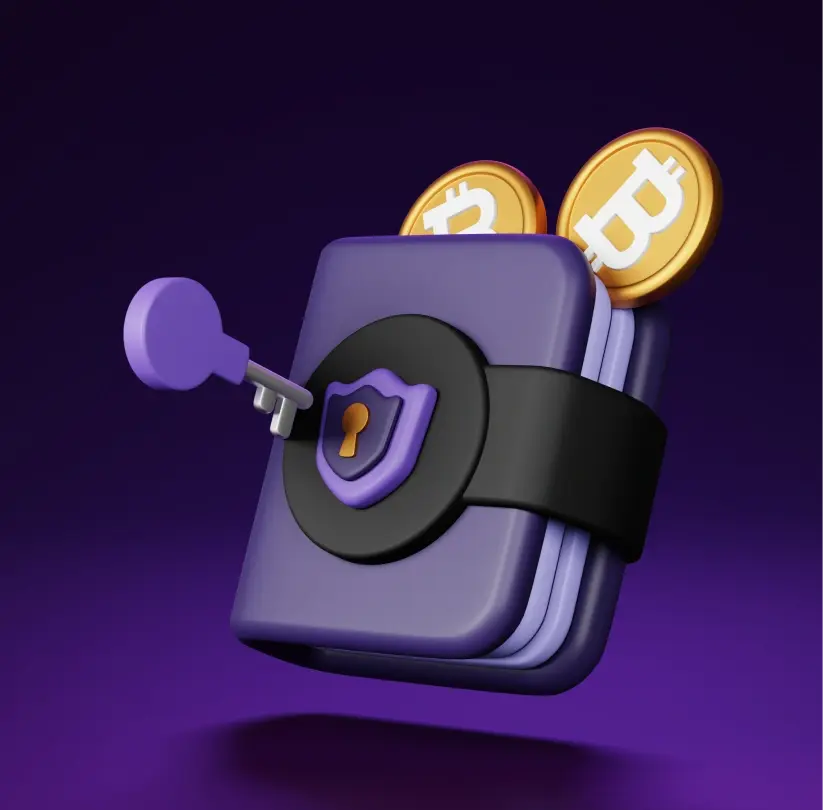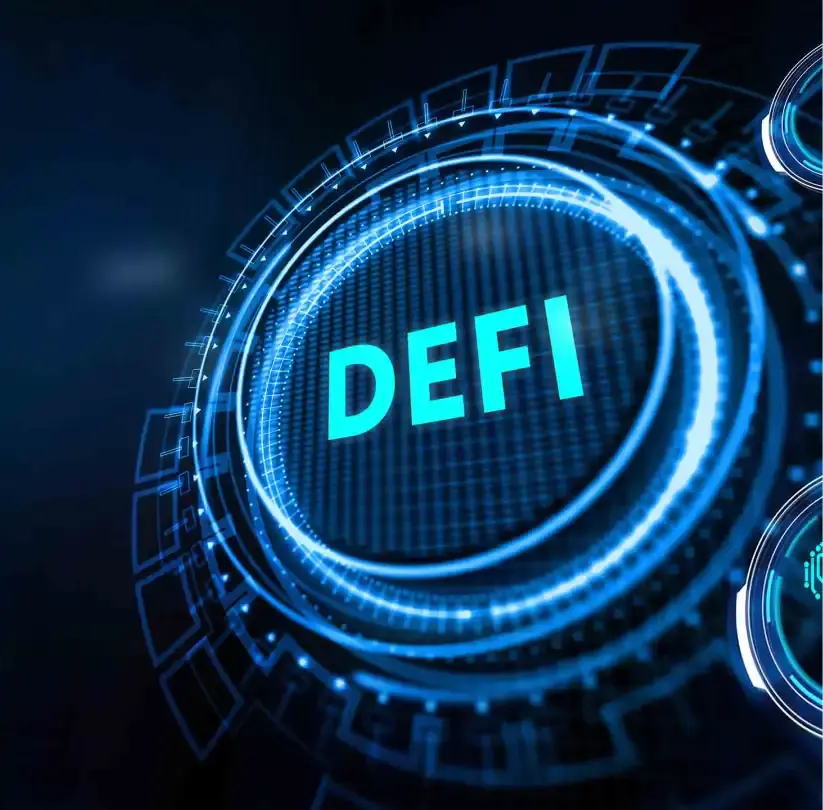Blockchain has emerged as a pivotal force propelling various industries, spanning finance, supply chain management, healthcare, and more. In this article, we delve into the expansive blockchain ecosystem, examining its burgeoning trends and possibilities that hold the potential to redefine the world.
The evolution of blockchain technology will be manifested in the expansion of decentralized finance, heightened regulatory measures, and increased integration with the Internet of Things (IoT) and artificial intelligence (AI). And these are not all the changes that await us in 2025.
Let’s explore the key blockchain trends 2025 will bring us!
Growth of the blockchain technology market
Businesses find value in blockchain due to secure data access, enhanced transparency, intrinsic validation, and improved efficiency and security. Its inherent decentralization facilitates data transfer without government (centralized) control. As Statista shows, spending on blockchain technologies is projected to exceed $19 billion by 2025.
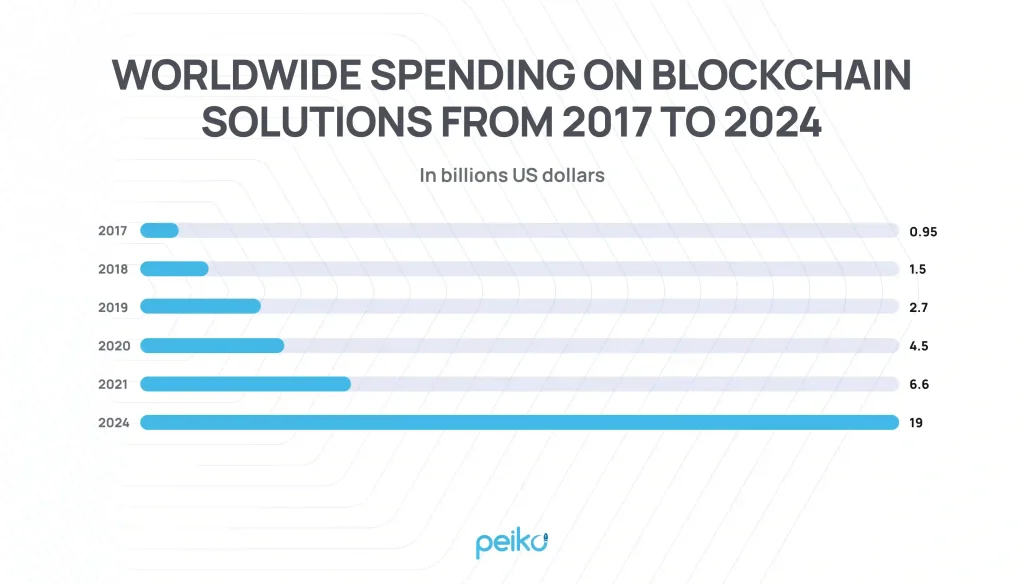
The ensuing blockchain growth stems from its adept handling of core issues. These are network trust, empowering enterprises to focus on problem-solving and reap its top pros.
The latest trends in blockchain technology
This section highlights the key blockchain trends for 2025, from emerging concepts to advancements in established practices. Let’s consider the evolution and impact of these trends as we delve into the exciting future of blockchain technology.
1. The quest for Ether alternatives
Nowadays, the transaction costs in blockchain networks posed a significant challenge for numerous projects, rendering some services economically unviable. Due to soaring transaction expenses, simple tasks such as saving a password or acquiring an NFT (non-fungible token) ticket for an event became impractical.
While Ethereum 2.0 held promise for fee reduction, the decline was not substantial enough to entirely eradicate the demand for more cost-effective alternatives. This situation has fueled a renewed interest in platforms such as Solana, Polygon, Avalanche, and others offering more economically viable solutions.
Thus, this blockchain trend reflects a pragmatic search for Ethereum alternatives that balance efficiency and affordability in the blockchain technologies niche.
2. The rise in enterprise blockchain adoption
As we approach 2025, businesses increasingly rely on utilizing blockchain-powered smart contracts. These contracts feature explicitly encoded terms within their code, making them self-executing. Upon satisfying specific criteria, these contracts operate automatically, contributing to cost reduction, streamlining complex processes, and diminishing the reliance on intermediaries.
A noteworthy application is observed in the real estate sector, where smart contracts facilitate seamless transactions and ensure all parties fulfill their responsibilities without complications.
An illustrative example comes from the retail giant Walmart, which employs blockchain technology to trace the food product’s journey from the farm to the table. This innovative approach ensures transparency and food safety, addressing critical concerns for consumers and businesses.
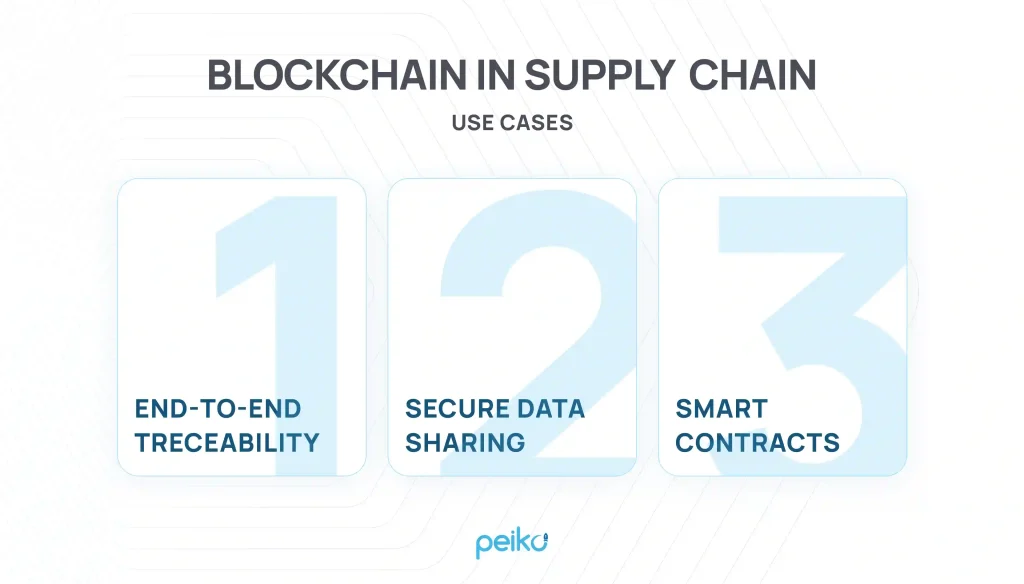
3. Leveraging crypto potential with Telegram
Telegram is now offering new opportunities for the crypto world with the introduction of Telegram cryptocurrency integration. This social network has millions of users and, therefore, offers the possibility of fast, peer-to-peer crypto transactions, token exchanges, and decentralized finance (DeFi) applications.
Telegram Mini Apps enable developers to build integrated services directly within Telegram, providing users with easy and smooth access to the crypto tools from within the app. This growing synergy between Telegram and crypto is enhancing the user experience, making digital assets more accessible and seamlessly woven into everyday communication. As Telegram continues to expand its features, its role in the crypto ecosystem is set to strengthen.
4. The growth of decentralized apps (dApps)
Decentralized finance has emerged as a pivotal blockchain trend in recent years.
Anticipating the trajectory into 2025, we foresee continuous growth and refinement within the DeFi community. The industry’s concerted efforts to address challenges related to scalability, security, and functionality are likely to result in more user-friendly DeFi systems. This will facilitate broader access for the general population. Also, this evolution could streamline access to banking services, eliminating the demand for traditional intermediaries.
The expansion of decentralized exchanges (DEXs), loan platforms, and yield farming protocols is expected to change the future of blockchain, fortify the DeFi ecosystem, and foster greater connectivity.
By the way, if you want to create a robust DeFi project, you can turn to Peiko. We will help you implement your vision into life. Vorpal is a great example of modern DEX. Our experts made it reliable and user-friendly, according to all client’s needs.

5. Adoption of central bank digital currencies (CBDCs)
Governments across the globe have shown significant interest in Central Bank Digital Currencies (CBDCs), and the year 2025 may witness substantial advancements in their development and adoption.
The potential benefits of CBDCs include simplifying banking systems, expanding financial access, and providing governments with enhanced regulatory tools.
As CBDCs evolve, discussions may intensify regarding the coexistence of state-backed digital currencies and decentralized cryptocurrencies. Striking a balance between innovative concepts and regulatory frameworks becomes crucial to fostering a harmonious collaboration between traditional financial systems and the expanding realm of cryptocurrencies.
6. Increasing blockchain regulation
Rising regulatory measures stand out as a pivotal force influencing the trajectory of crypto security. As the cryptocurrency and digital asset sector matures, global governments and regulatory entities are intensifying their endeavors to establish well-defined guidelines and frameworks for these nascent technologies.
This heightened regulatory focus aims to solve the following issues:
- Bolster investor protection,
- Curtail fraud,
- Combat money laundering,
- Address other illicit activities.
The implementation of more stringent regulations instills greater confidence in individuals and businesses looking to engage in the crypto sphere. Moreover, increased regulatory scrutiny serves to identify and eliminate malicious actors, fostering a safer environment for all participants.
7. Adoption of AI-enabled blockchain
In 2025, the convergence of AI and blockchain technologies is set to reshape our digital landscape significantly. This powerful alliance is one of the top blockchain industry trends.
AI-driven algorithms play a crucial role in enhancing the efficiency of blockchain networks. They contribute to making consensus mechanisms more flexible, a vital aspect as blockchain continues to expand to accommodate a growing user base and increased transactions.
Exploration into the synergies of AI has commenced with projects like Ocean Protocol and Cosmos. These initiatives aim to revolutionize trading strategies and enhance immersive experiences within the metaverse. Pioneering the integration of AI and crypto, projects such as Fetch.ai and The Graph lead the way in innovation, unlocking novel use cases across various sectors.
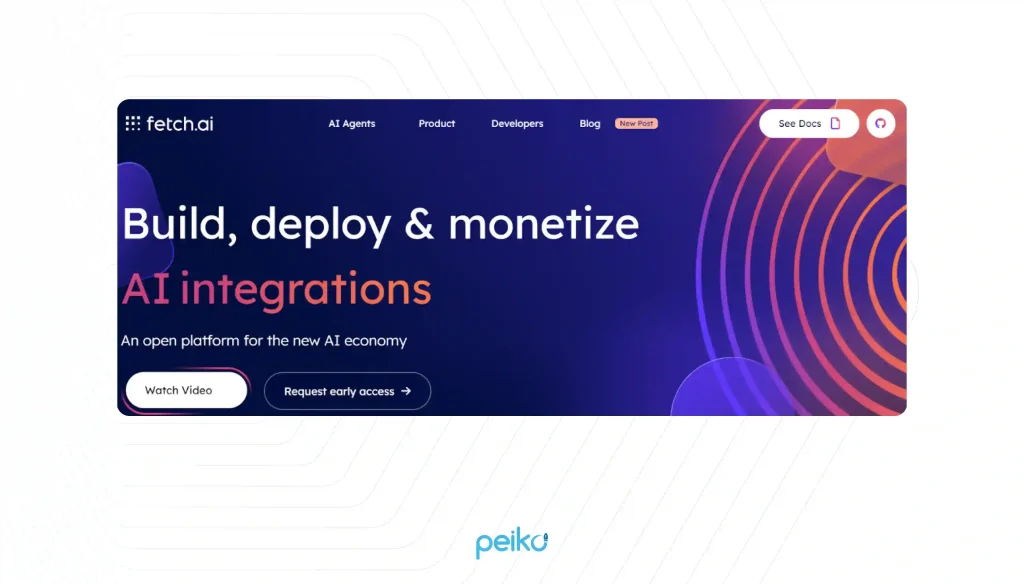
8. Advanced education in blockchain
The upsurge in blockchain education is one of the notable blockchain trends 2025 brings. Many institutions are increasingly channeling investments into blockchain technology to maintain competitiveness. JPMorgan Chase & Co., a bank in New York, for instance, has committed over $1 billion to blockchain technology.
Also, a leading investment banking company, Goldman Sachs, has established a dedicated division focused on blockchain and digital assets.
The Chinese government is actively creating a national blockchain infrastructure, and in India, blockchain technology is being employed to manage land records.
Accessibility to blockchain courses, workshops, and online resources is increasing, empowering learners to comprehend the technical nuances of blockchain, its foundational principles, and practical applications.
9. Increased stablecoin supply
Stablecoins, tied to fiat currencies or other assets, offer a consistent value, providing a stable alternative to the volatility of cryptocurrencies like Bitcoin or Ethereum. Investors often turn to stablecoins for stability, acting as a secure link between traditional finance and the crypto realm.
The increase in stablecoin adoption in 2025 is also one of the main trends in blockchain in 2025. Amid ongoing economic uncertainties, investors may gravitate toward stable assets, heightening the demand for stablecoins. Additionally, the continued integration of stablecoins in decentralized finance (DeFi) and cross-border transactions may contribute to their expanded usage.
According to data from DefiLlama, the total market capitalization of stablecoins is nearing a new all-time high of $213 billion in 2025.
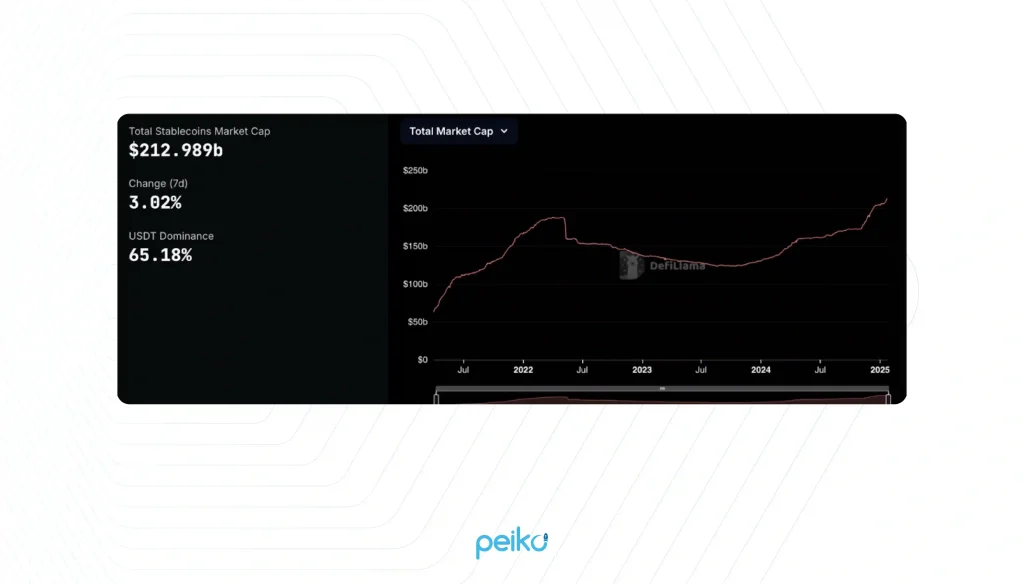
10. The growth of the asset tokenization trend
Asset tokenization, the conversion of real-world assets into digital tokens on the blockchain, emerges as a top blockchain trend. This process has the potential to revolutionize accessibility and streamline trade.
This innovation ensures that everyday individuals can participate in the investment of high-value assets such as art or real estate.
Examples of asset tokenization:
- The real-world asset tokenization process encompasses converting assets like fiat currency, equities, T-bills, credit, commodities, carbon credits, intellectual property, and art. Similar to conventional gold bullion assets and house deeds, these tokens represent bearer assets, granting the holder a claim over a physical asset.
- Digital asset tokenization, crucial in the Web3 era, focuses on tokenizing assets that exist solely in digital form on a blockchain network. This is particularly relevant for use cases involving cross-chain assets and DAO (decentralized autonomous organization) governance rights. As entirely digital entities, tokenized assets on a blockchain grant the owner direct ownership of the asset itself rather than a claim on the underlying asset.
- Tokenization of in-game assets involves the representation of assets utilized in GameFi projects or metaverses. Examples include tokenized representations of skins, weapons, or in-game currencies.
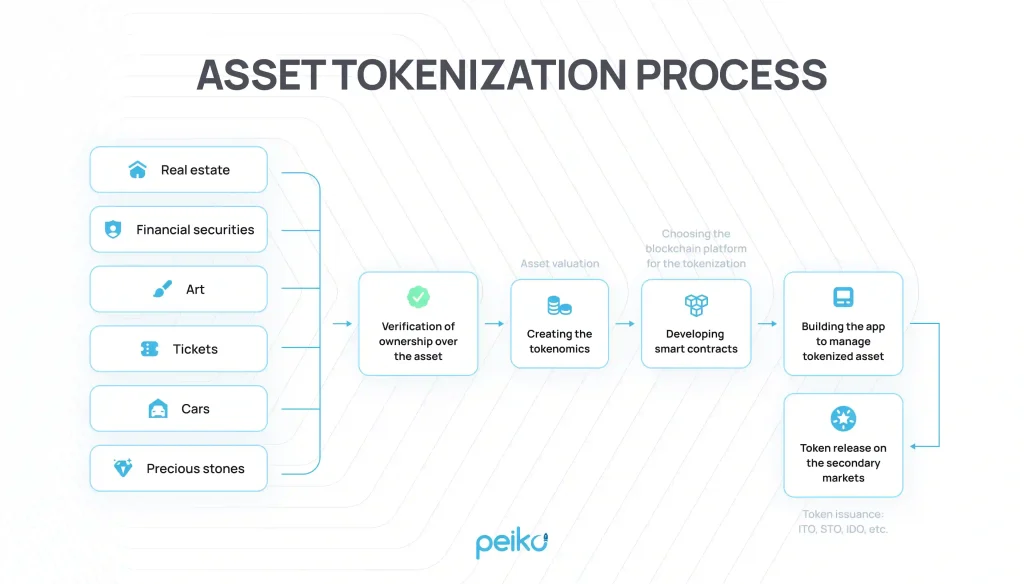
11. Layer-1 solutions are still promising
Although Ethereum continues to hold its position as the primary smart contract L1 based on various metrics, alternative L1 solutions have displayed considerable potential throughout the year 2024.
Monitoring this blockchain trend as we step into 2025 will be essential to determine whether Ethereum can maintain its dominance in the L1 landscape.
Below, you can see some examples of Layer-1 blockchain projects that have great promise in 2025.
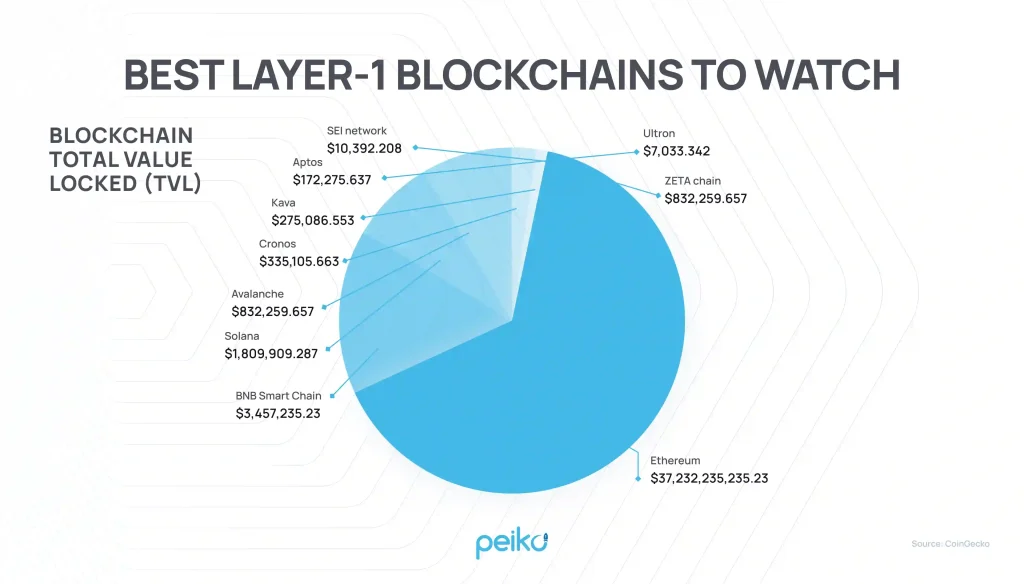
12. The spread of advanced privacy solutions
Undoubtedly, there are numerous fraudsters and criminals in the crypto landscape who have garnered fame (and substantial profits). The incidents, including the FTX collapse and penalties imposed on Binance, might only represent the beginning of potential challenges if the industry continues its projected rapid growth. So, privacy and security solutions are especially vital in 2025.
The integration of cutting-edge technologies and protocols will mark their development and enhancement progress. Notable examples include:
- Zero-knowledge proofs: Employing cryptographic techniques like zk-SNARKs (zero-knowledge succinct non-interactive arguments of knowledge) to enable secure transactions without revealing underlying details.
- Confidential transactions: Implementing mechanisms that encrypt transaction amounts, ensuring financial privacy within the blockchain.
- Homomorphic encryption: Facilitating computations on encrypted data, preserving the confidentiality of sensitive information throughout blockchain processes.
- Decentralized identity solutions: Introducing self-sovereign identity systems to enable users to control their personal information, enhancing privacy in various interactions.
- Ring signatures: Augmenting transaction privacy by blending a user’s signature with those of others, creating a challenge in tracing the origin of specific transactions.
- Privacy coins: Continued refinement and adoption of privacy-focused cryptocurrencies such as Zcash (ZEC) and Monero (XMR), prioritizing user anonymity.

13. The fusion of blockchain and the Internet of Things (IoT)
The landscape of our interaction with the world has been reshaped by the Internet of Things (IoT), introducing a network of physical objects equipped with sensors, software, and connectivity for seamless data collection and exchange. These intelligent devices, encompassing everyday items such as wearables to intricate industrial machinery, have paved the way for transformative possibilities.
By facilitating communication between devices and internet-connected platforms, IoT empowers smart devices to autonomously execute tasks and share information. Examples include monitoring environmental conditions on farms, optimizing traffic flow through smart cars, controlling industrial machinery, or managing warehouse inventory.
Blockchain is set to revolutionize the Internet of Things in 2025, with the trends in blockchain focusing on decentralized architecture and cryptographic encryption tools.
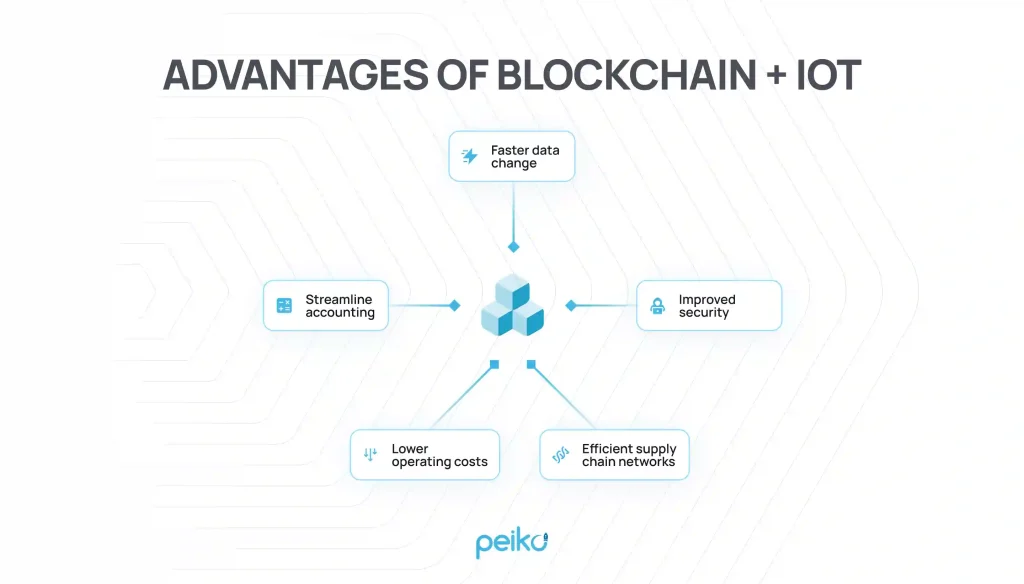
14. The rise in blockchain gaming
Blockchain gaming is about to undergo a significant shift in 2025. The networks will consolidate to make the ecosystem smoother and more interoperable, while Web4 technology will make blockchain elements seamless and user-friendly.
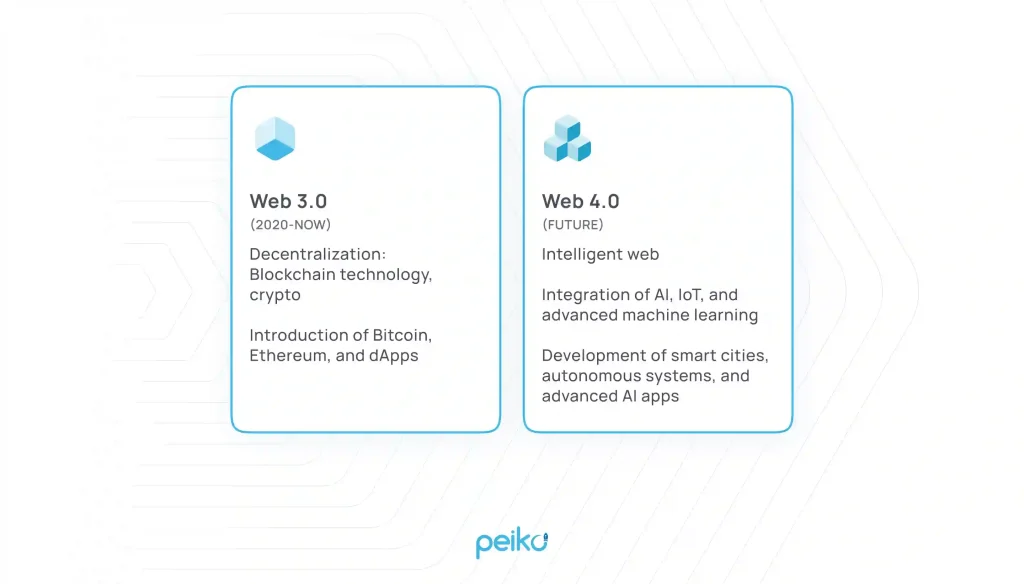
AI will personalize gameplay, making experiences more adaptive to individual preferences. Interoperability will enable players to carry achievements across games. While challenges persist, blockchain gaming is on course for rapid evolution and expansion.
15. The ascent of layer-2 solutions
This is also one of the popular blockchain industry trends for 2025.
Smart contracts, integral to blockchain technology for their self-executing and programmable nature, are set to undergo significant enhancements because of L2 scaling solutions in Smart Contracts 2.0. The primary objective is to address scalability issues that prominent blockchains, including Ethereum, have faced, resulting in high transaction fees and prolonged approval times.
The implementation of layer-2 options, such as Optimistic Rollups and zk-Rollups, aims to enhance the efficiency of smart contract systems, making them more accessible and cost-effective. This innovative development has the potential to introduce new options for dApps and stimulate greater adoption by simplifying existing blockchain networks.
Blockchain technology trends across industries
From the transformation of finance and healthcare to a change in gaming and supply chains and even the energy market, everything is possible with blockchain. Let’s consider how this technology will influence main business sectors in 2025:
Financial services
Blockchain trends 2025 will continue to change the financial sector. Blockchain will improve the financial sector through enhanced security, transparency, and operational efficiency. For instance, in the area of trade finance, blockchain will facilitate seamless international payments, reduce fraud cases, and shrink transaction costs. Furthermore, smart contracts and tokenized assets will facilitate faster transactions and reliability in financial dealings.
Healthcare
Blockchain will revolutionize healthcare by addressing issues around data security, interoperability, and transparency. It will enable secure sharing of patient data across various healthcare providers, giving patients more control over their information. This will lead to faster diagnoses, improved treatment coordination, and more efficient medical research.
Media and entertainment
Blockchain, in the gaming sector, will give players legitimate ownership of in-game assets through NFTs, encourage decentralized economies in gaming, and enhance transactional transparency. Beyond this, blockchain can help decentralize social networks; users can manage their personal data and online identity as opposed to a centralized platform.
Government
Governments will increasingly adopt blockchain for enhancing public services, such as voting, land registries, and identity verification. Blockchain-based voting could eliminate fraud, making elections more secure, while tamper-proof land registries would make property transactions more efficient and transparent.
Retail (eCommerce)
Blockchain will improve supply chain transparency and reduce fraud in the retail space as it enhances the trust between buyers and sellers. For example, customers could track a product from manufacturer to end-user to check its origin and content for ethical source and origin. This increases customer loyalty and reinforces the brand’s reputation.
Energy market
Blockchain trends 2025 will revolutionize the energy market by allowing decentralized energy trading, which enhances distribution efficiency. Smart contracts could enable energy consumers to directly trade energy with other energy consumers, thus rendering energy systems sustainable. In addition, blockchains will ensure transparency in the tracking of energy consumption and production of renewable energy for a greener future.
Peiko is a top blockchain development agency
Our blockchain development services company stands out as a premier development partner ready to assist you in launching a freshly crafted blockchain solution or enhancing your current systems. Since 2017, we have crafted many successful blockchain projects, including cryptocurrency exchange development, crypto wallet creation, and many others.
Peiko’s proficient blockchain developers are dedicated to providing exceptionally secure, creative, and autonomous solutions. We always start with expert blockchain development consulting to understand your requirements and harness cutting-edge technologies to help clients make a lasting impact on their businesses and foster customer growth.
We offer one of our successful projects to your attention. Swych is a robust, user-centric decentralized crypto exchange built to optimize functionality and deliver a seamless user experience.
Similar to PancakeSwap, it goes beyond basic token trading by integrating liquidity pools, yield farming, and advanced tools.
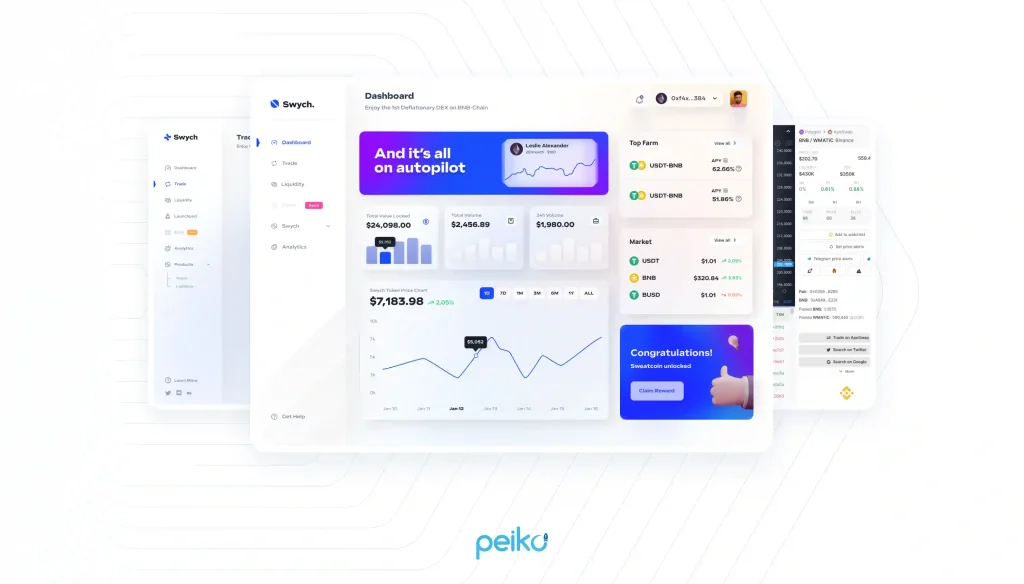
Key results the client got
- DEX screener. A powerful tool for exploring promising tokens, liquidity pools, and farming options.
- BSC & BNB integration. Fast and efficient transactions powered by Binance Smart Chain and Binance Coin.
- Launchpool & farming features. Liquidity pools and farming opportunities are easily invested in through an intuitive dashboard.
- Unique design. A unique, visually appealing interface built from Figma designs for both aesthetic and usability purposes.
- High-performance solution. Fast transaction processing and optimized slippage management for smooth trades.
- Exciting gaming experience. Integrating gaming elements to make trading an engaging and interactive experience.
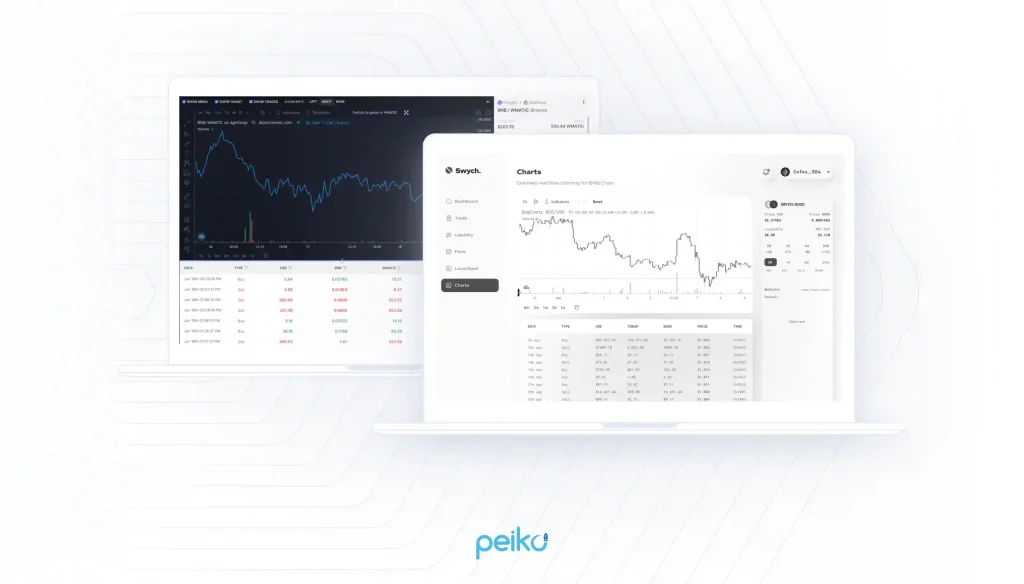
Wrapping up
Worldwide experts are anticipating 2025 to mark a significant breakthrough for blockchain technology. The year is poised to witness a substantial uptick in blockchain adoption by both enterprises and governments.
This surge is attributed to the continuous growth of DeFi, the ever-expanding realm of cryptocurrency tokens, the intersection of AI and blockchain, the rise of regulatory measures, and many other factors.
Is the blockchain the future? Definitely, yes. To create a personal blockchain project following the emerging blockchain trends, turn to Peiko. Contact us to share your ideas and receive professional blockchain development services!





